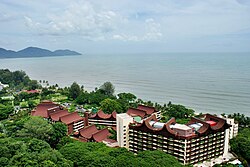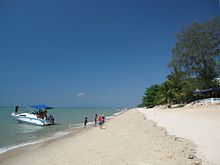Batu Ferringhi
Batu Ferringhi | |
|---|---|
Suburb of George Town | |
| Other transcription(s) | |
| • Chinese | 峇都丁宜 |
| • Hokkien | Bâ-too-teng-gi (Tâi-lô) |
| • Tamil | பத்து பெரிங்கி |
 | |
 | |
| Coordinates: 5°28′5.88″N 100°14′31.2″E / 5.4683000°N 100.242000°E | |
| Country | |
| State | |
| District | Northeast Penang Island |
| City | |
| Government | |
| • Local government | Penang Island City Council |
| • Mayor of Penang Island | Yew Tung Seang |
| • Tanjong Bunga State Assemblyman | Zairil Khir Johari (DAP) |
| • Bukit Bendera Member of Parliament | Wong Hon Wai (DAP) |
| Time zone | UTC+8 (MST) |
| • Summer (DST) | Not observed |
| Postal code | 11100 |
| Website | mbpp |
Batu Ferringhi is a suburb of George Town in Penang, Malaysia. Located along the northern coast of Penang Island and about 11 km (6.8 mi) northwest of the city centre, it is the prime beach destination in Penang among locals and tourists. To cater to the influx of tourists, several major high-rise hotels have been established along the 4 km (2.5 mi) stretch of beaches, including Hard Rock Hotel.
The beach resorts along Batu Ferringhi also offer various water sport activities, such as parasailing. On a clear day, one could get a picturesque view of the Andaman Sea and Mount Jerai, which is located within the neighbouring state of Kedah. In addition, Batu Ferringhi is famous for its night market that offers a wide variety of merchandise and street food.
There had been human activity within Batu Ferringhi as early as 1592, when an Englishman, Sir James Lancaster, arrived and began pillaging other vessels around Penang Island.[1][2] However, for much of its recent history, Batu Ferringhi was a quiet village, until the urbanisation of the area beginning in the 1970s.
Due to its location along the northern coast of Penang Island, Batu Ferringhi was hard hit by the 2004 Indian Ocean earthquake and tsunami.[3]





Etymology
The word ferringhi or feringgi is a modern spelling of the Classical Malay word peringgi, originally used in reference to the Portuguese conquistadors before being all people of European descent. It is cognate with the Thai farang and Khmer barang. All derive from the Indian word firangī (फ़िरंगी) which itself originates either with the Arabic ferringi or Persian farangi. In the Middle East and Africa, it originally referred to the Franks but came to mean Europeans in general.
Batu Ferringhi, therefore, would mean the place where Westerners had come ashore, with the Malay word batu (meaning rock) referring to the rocky shoreline of this particular area.
Among Tamils, the area is known as Paringgi Malai meaning "foreigner's hill".
History
Batu Ferringhi was first explored in 1592, when Sir James Lancaster, an English privateer, came ashore at this particular area.[1][2] This made Lancaster the first European to reach Penang Island. Having come ashore aboard the Edward Bonaventure, Lancaster and his crew proceeded to pillage every vessel they encountered for the next four months.
The urbanisation of Batu Ferringhi only began in the 1970s. This involved the construction of several hotels along the beaches, attracting locals and tourists alike. Condominiums soon followed, offering gorgeous views of the sea overlooking the Malay Peninsula. However, these developments did not come without problems, such as the deteriorating seawater quality that has led to the infestation of jellyfish around Batu Ferringhi.[4]
Batu Ferringhi was one of the hardest hit areas during the 2004 Indian Ocean tsunami that ultimately claimed a total of 52 lives in Penang.[3]
In 2009, Hard Rock Hotel opened its Penang branch at Batu Ferringhi, adding to the list of major hotels already within the suburb.
Transportation
The main thoroughfare within Batu Ferringhi is the coastal Batu Ferringhi Road, part of Federal Route 6. Batu Ferringhi Road continues on from Tanjung Bungah Road, cutting through the heart of the suburb until it becomes Jalan Teluk Bahang at the western edge of Batu Ferringhi. The few roads within this suburb, including Batu Ferringhi Road, are prone to traffic congestion due to its popularity as a tourist destination.[5]
Rapid Penang buses 101 and 102 serve the residents of the suburb, by connecting Batu Ferringhi with George Town and other destinations on Penang Island, such as Tanjung Bungah, Tanjung Tokong, the Penang International Airport and Queensbay Mall.[6][7]
Another bus service, the Hop-On Hop-Off service, caters primarily to tourists.[8] This service, which utilises open-topped double decker buses, includes three stops within Batu Ferringhi - an optional stop at Miami Beach and two standard stops at Holiday Inn and Hard Rock Hotel.[9]
Education
The only school within the Batu Ferringhi suburb is the Uplands International School, which caters primarily to the expatriate community within this suburb as well as those from the neighbouring Tanjung Bungah suburb.
The nearest public primary and high schools are situated at Tanjung Bungah.
Shopping
Although Batu Ferringhi does not have a shopping centre, the suburb is notable for its night market. Souvenirs, DVDs, artworks, jerseys, and other apparels and accessories can be found at bargain prices within the night market, which is also lined with various food stalls that sell Penang's famed street cuisine and titbits.[10][11][12]
Tourist attractions
- Miami Beach
- Lovers' Isle
- Batu Ferringhi Night Market[10][11]
- Hard Rock Hotel
References
- ^ a b "The island". www.footprinttravelguides.com. Archived from the original on 2014-06-02. Retrieved 2016-11-11.
- ^ a b Staff, ExpatGo (2014-06-24). "Sailing Around Penang with Three Expats in a Small Boat". ExpatGo. Retrieved 2016-11-11.
- ^ a b "Boxing Day tsunami, 10 years on: 'The water came - my family is gone'". Telegraph.co.uk. Retrieved 2016-11-11.
- ^ Yee, Kow Kwan. "Sea change for Batu Ferringhi - Community | The Star Online". Retrieved 2016-11-11.
- ^ "Alleviating traffic congestion in Penang - Features | The Star Online". www.thestar.com.my. Retrieved 2017-05-21.
- ^ "Archived copy". Archived from the original on 2016-07-02. Retrieved 2017-05-21.
{{cite web}}: CS1 maint: archived copy as title (link) - ^ "Archived copy". Archived from the original on 2016-06-30. Retrieved 2017-05-21.
{{cite web}}: CS1 maint: archived copy as title (link) - ^ "myPenang - Penang Hop-On Hop-Off is here!". mypenang.gov.my. Archived from the original on 2017-08-22. Retrieved 2017-05-20.
- ^ "Penang Hop-On Hop-Off Official Website". www.myhoponhopoff.com. Retrieved 2017-05-20.
- ^ a b "Batu Ferringhi Night Market". Time Out Penang. Retrieved 2017-05-21.
- ^ a b Planet, Lonely. "Batu Ferringhi Night Market in Batu Ferringhi, Malaysia". Lonely Planet. Retrieved 2017-05-21.
- ^ "How to spend 24 hours in Penang". Retrieved 2017-05-21.
External links
 Batu Ferringhi travel guide from Wikivoyage
Batu Ferringhi travel guide from Wikivoyage

